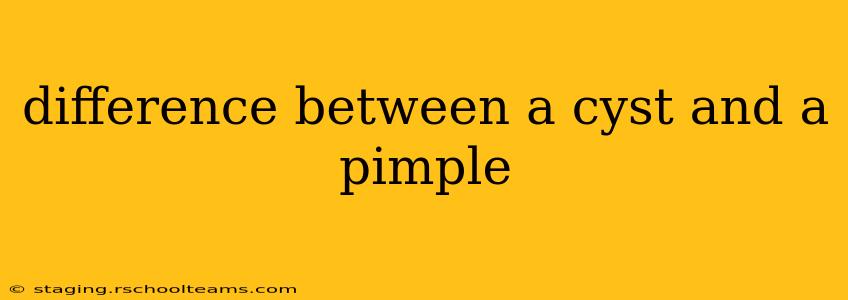The Difference Between a Cyst and a Pimple: Understanding Skin Lesions
Many people confuse cysts and pimples, but these skin lesions are quite different in their formation, characteristics, and treatment. Understanding these distinctions is crucial for proper diagnosis and effective management. This article will explore the key differences between cysts and pimples, addressing common questions and misconceptions.
What is a Pimple?
A pimple, or acne pustule, is a common skin lesion resulting from a clogged pore. Sebum (oil) and dead skin cells block the pore, creating a perfect environment for bacteria to thrive. This leads to inflammation, redness, and often a pus-filled head. Pimples are typically superficial, affecting only the upper layers of the skin. They are usually smaller than cysts and often resolve on their own within a few days or weeks.
What is a Cyst?
A cyst is a sac-like structure that forms beneath the skin's surface. Unlike a pimple, which is primarily an inflammatory response to bacteria, a cyst contains fluid, semi-solid material, or other substances enclosed within a membrane. Cysts can vary significantly in size, from tiny to quite large, and can occur almost anywhere on the body. They can be painful or painless, depending on their location, size, and contents. Unlike a pimple, a cyst is usually deeper within the skin.
What are the Key Differences Between a Cyst and a Pimple?
Here's a table summarizing the key differences:
| Feature | Pimple (Acne Pustule) | Cyst |
|---|---|---|
| Cause | Clogged pore, bacterial infection | Blockage of a gland, tissue growth, infection |
| Location | Primarily on the face, back, chest | Can occur anywhere on the body |
| Depth | Superficial (upper layers of skin) | Deeper within the skin |
| Size | Generally small | Can range from small to very large |
| Appearance | Red, inflamed, often with a pus-filled head | Often firm, round, and may be discolored |
| Pain | Can be painful or mildly tender | Can be painful or painless, depending on size and location |
| Duration | Usually resolves within a few days or weeks | Can persist for weeks, months, or even years |
| Treatment | Over-the-counter acne treatments, sometimes medical intervention | May require medical intervention (drainage, excision) |
How Can I Tell the Difference?
Differentiating between a cyst and a pimple can be challenging. A pimple usually has a visible head filled with pus, while a cyst may appear as a firm lump beneath the skin. The size and depth of the lesion can also be helpful indicators. However, if you are unsure, it's always best to consult a dermatologist for accurate diagnosis and treatment.
What are the Treatment Options for Cysts and Pimples?
Pimples: Many pimples can be treated at home with over-the-counter acne treatments containing benzoyl peroxide or salicylic acid. Severe or persistent acne may require prescription medications.
Cysts: Cysts often require professional medical attention. Treatment may involve draining the cyst, surgically removing it, or using other medical interventions depending on the type and location of the cyst. Attempting to drain a cyst at home can be risky and may lead to infection.
Can Pimples Turn into Cysts?
While a pimple itself doesn't typically transform into a cyst, severe or persistent inflammation from acne can sometimes lead to the formation of nodules or cysts. This is less common than a simple pimple.
When Should I See a Doctor?
Consult a dermatologist if:
- You have a large or painful cyst.
- A cyst is recurring or doesn't heal.
- You experience signs of infection (increased pain, redness, swelling, pus).
- You have many pimples and over-the-counter treatments aren't working.
This information is for general knowledge and does not constitute medical advice. Always consult a healthcare professional for diagnosis and treatment of any skin condition.
